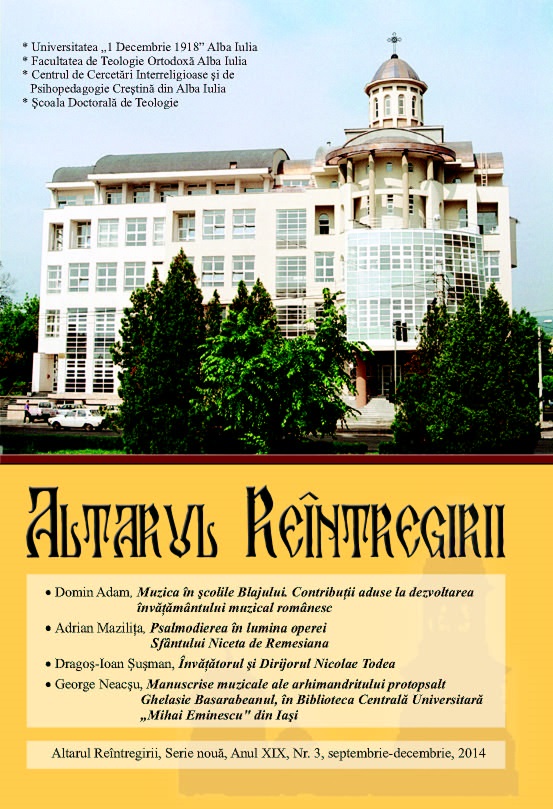Psaltichia bisericească a mitropolitului Bucovinei, dr. Silvestru Morariu-Andrievici, prima transcriere a unei părţi din muzica bisericească tradiţională, psaltică, românească, pe notaţia liniară. Ecouri în şi din Principatele Române (partea a II-a).
The Church Psaltic Music Collection of the Metropolitan of Bucovina, dr. Silvestru Morariu-Andrievici, the first transcript of a part of the Romanian traditional, Psaltic Church music, into liniar notation. Echoes in and from the Romanian Principalit
Author(s): Costel-Mirel NechitaSubject(s): Fine Arts / Performing Arts, Music
Published by: Facultatea de Teologie Ortodoxă Alba Iulia
Keywords: Bucovina; transcription; music bisericescă; Byzantine; vespers; Anastasimatar; voices; third step
Summary/Abstract: Some Romanian provinces: Bukovina, Transylvania, Banat and Oltenia were occupied in twelfth and thirteenth centuries, the Austro-Hungarian Empire. Although the term occupation was still Romanians have lost their identity, culture, language and faith . To meet the tests of all kinds in Bucovina cultural Society founded by weather personalities, among which Dr. Sylvester - Morariu Bukovina metropolitan Andrievici (1818-1895), whose name is linked, among other, Bucovina school history and culture. Also his name is bound transcription Psaltichia church first part of traditional church music, Performers, Romanian, the linear notation, document national and universal value. In this study we examine the paper in comparison with church hymns after eight voices songs collected in Transylvania and published by Father Dimitrie Cunţanu in 1890 with songs in Romanian Anastasimatarele chosen and edited to even Anastasimatarul songs Vecernierul or Vespers on Saturday evening on the eight voices of Nicolae Lungu church, Gregory Costea, Ion Croitoru. The purpose of the analysis is to see if the Romanian lands occupied and cultivated kept their church musical values, as happened across the country, if these values are related and unity with the other Romanian principalities and if there is unity in church singing between church composers our country.
Journal: Altarul Reîntregirii
- Issue Year: XIX/2014
- Issue No: 3
- Page Range: 23-36
- Page Count: 13
- Language: Romanian

